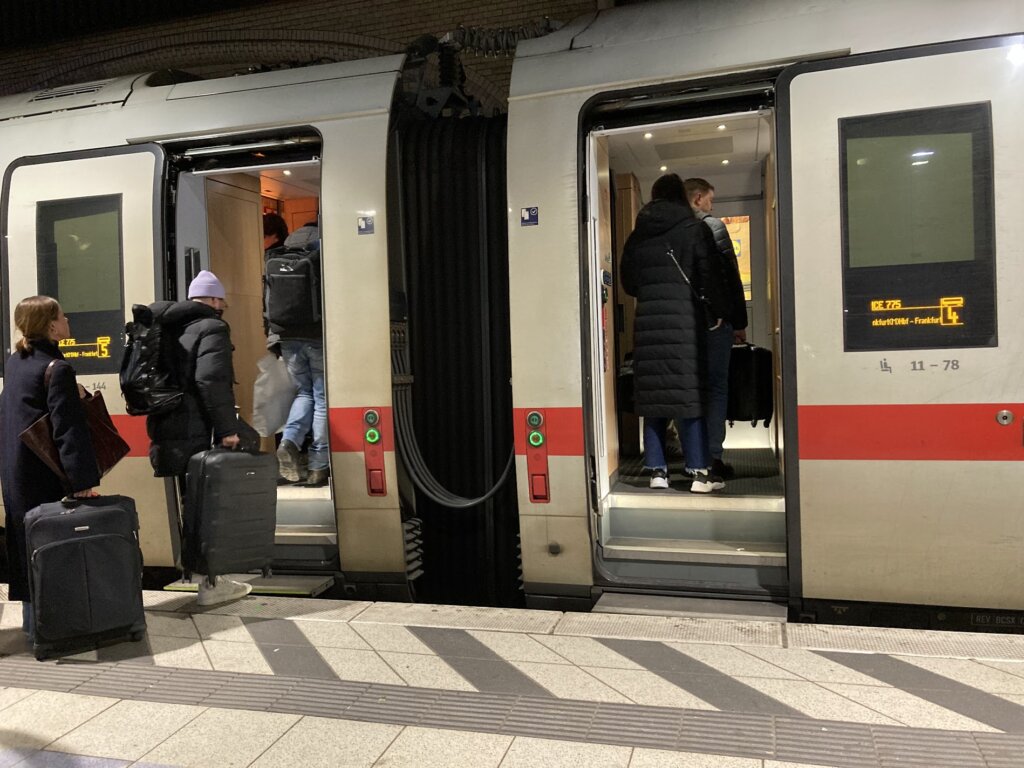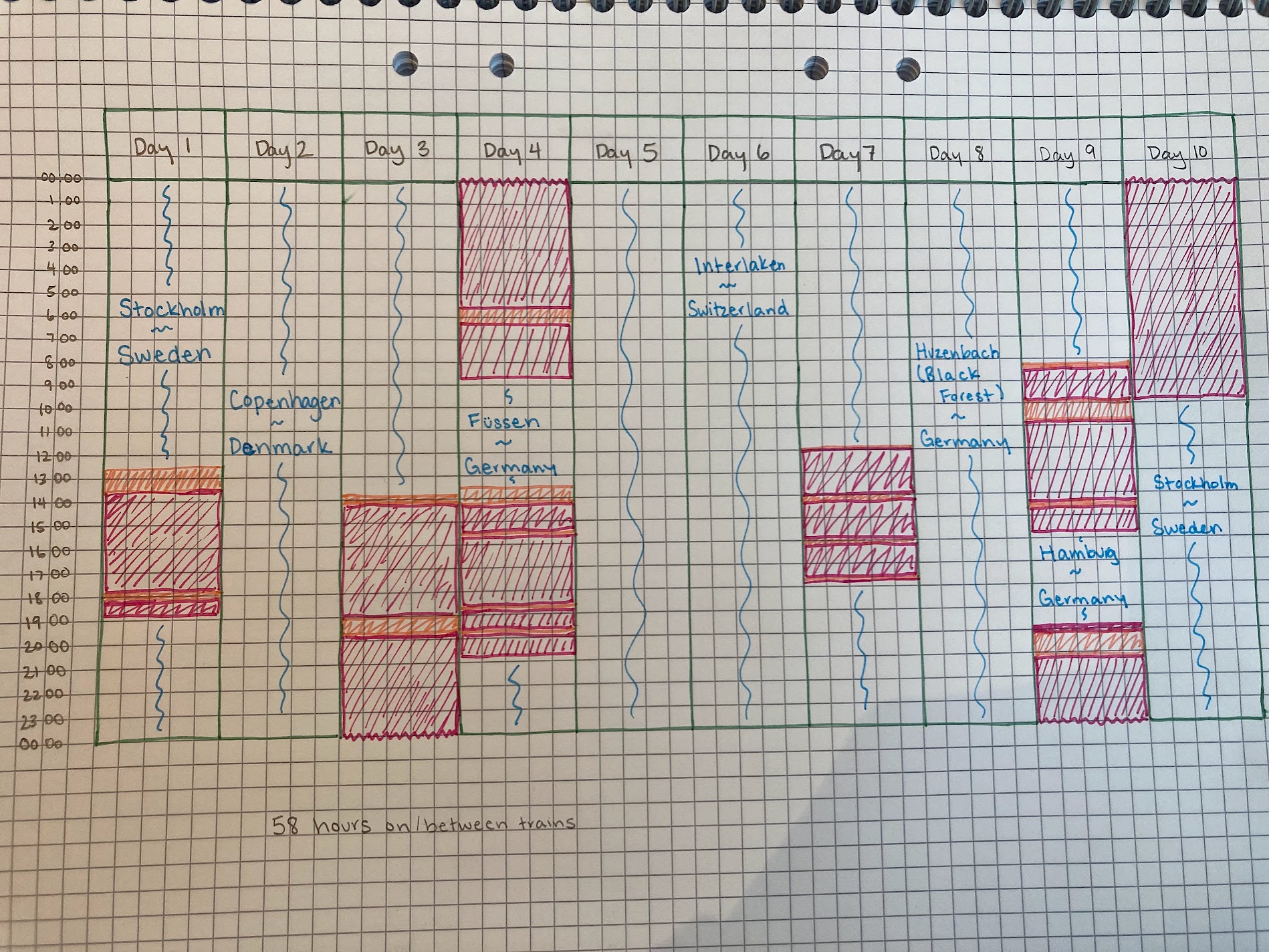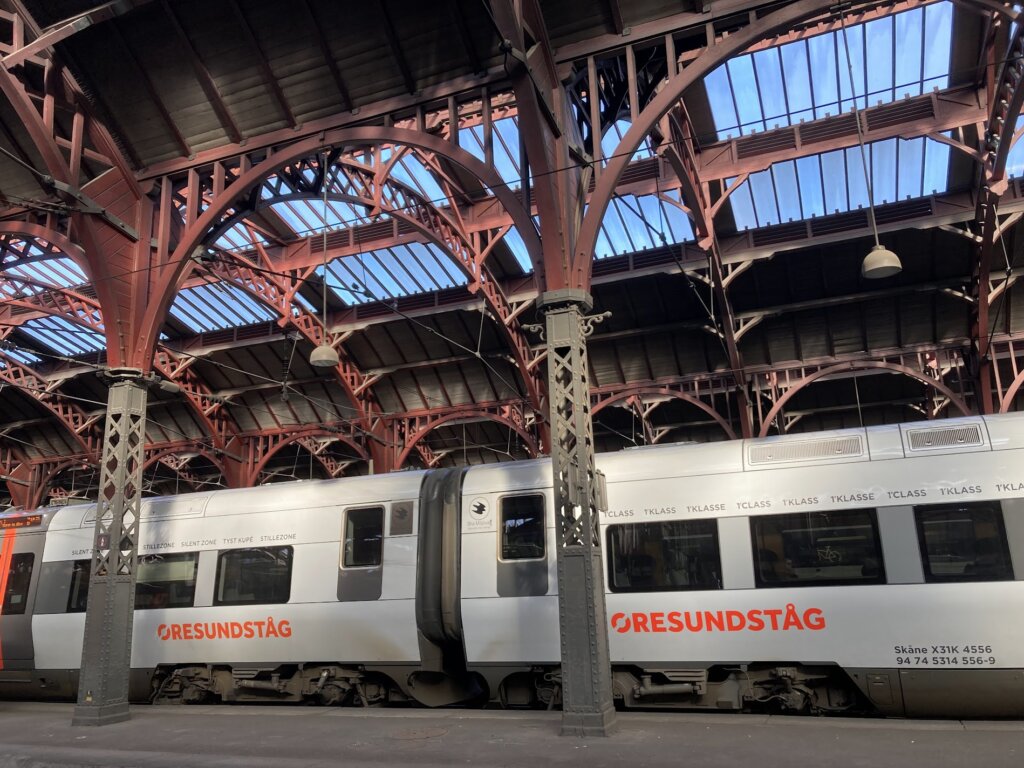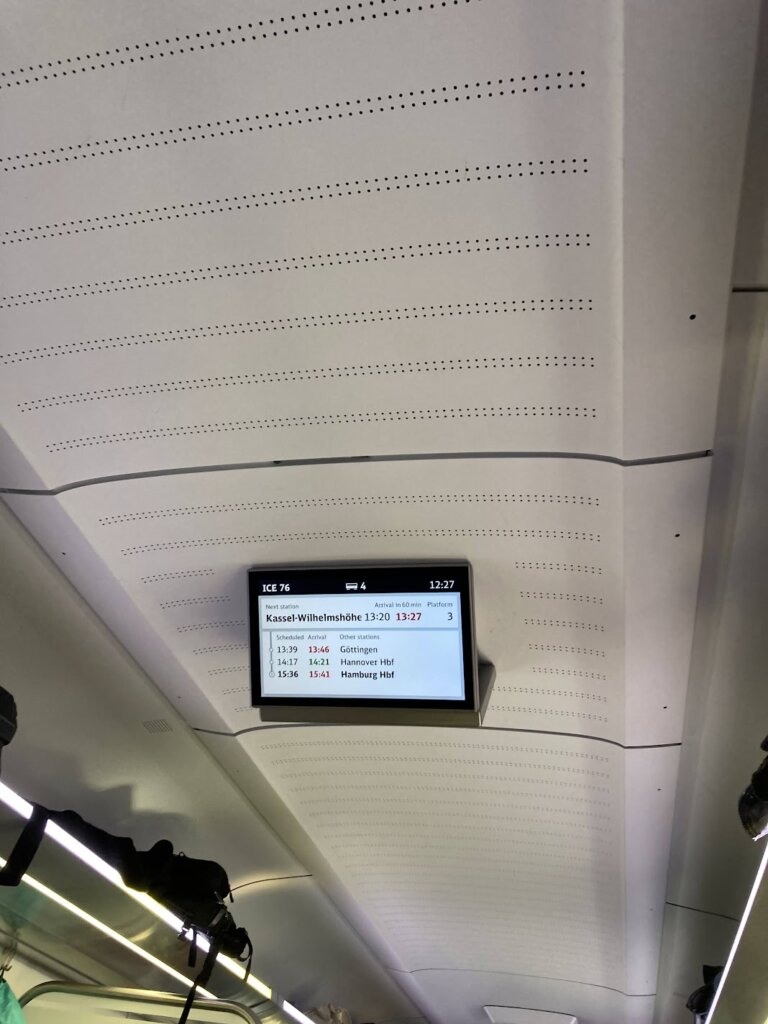
DIS Blog
How to slow travel by train with Eurail
“This guide is for those of you who are thinking about embracing slow travel, but maybe don’t have much experience with trains.”
DIS Stockholm student, Maya (she/they, Grinnell College), used a Eurail pass and her travel week to journey from Stockholm all the way to Switzerland and back.
Read below to get Maya’s tips on all things trains, from planning your journey to the details you can expect as you travel.

This guide is for those of you who are thinking about embracing slow travel, but maybe don’t have much experience with trains. I know I sure had a lot of questions before my first ever train trip – 58 hours on 17 trains in 10 days – and there weren’t a lot of answers, so I wanted to give you answers to some of the questions that I had before leaving on my trip.
All of the information here is anecdotal, so the experience may not reflect other train trips. I traveled from Stockholm to Copenhagen and then spent most of my time primarily in Switzerland and Germany during the winter season, so I was not traveling around a holiday or in the more busy summertime.
(And if you are looking for even more info, The Man in Seat 61 has an even more detailed guide, but there is so much good information that I found it overwhelming and a little difficult to navigate)
Eurail: Yes or No?
Eurail is a very convenient way to travel by train, but is it worth it? That depends on how many trains you are taking.
I recommend starting with the Eurail planner to find your route to your destination, then check those same routes with the individual train companies to see if booking through Eurail or individual train tickets is more cost effective for your trip.
Individual train tickets can cost anywhere from $20 to $100 for a second-class ticket and they generally require you to commit to traveling at a specific time and day. Eurail, on the other hand, has a wide variety of options for different situations.
Flexible Youth Eurail tickets are available to anyone 27 or younger and range from $255 (5 days of travel over a month) to $440 (15 days of travel over two months).
The “flexible” option means that you have some more wiggle room built into your travels since you have a set number of days of travel within a time period, but you don’t have to commit to the exact day or time beforehand. That being said, with Eurail, you may have to pay an extra seat reservation cost to ensure you’ve got a seat on certain trains. These are generally night trains or high speed international trains.
Be sure to double check if a reservation is required, and also make sure you buy a youth ticket for cheaper prices!
There are also options for consecutive days of travel starting at 15 days in a row, or single country passes, so you have many options to choose from with Eurail.
Once you have done the math, choose the better option for you. If the costs are similar, go for Eurail. You get significantly more flexibility if something goes wrong.
The Eurail App is also just generally super convenient. You have to have it if you are traveling with a Eurail ticket, but even if you are traveling on individual tickets, the app still shows you all departures from most stations, even if they are out of the Eurail network.

How long is too long to train?
I found that train travel is much less tiring than airplane travel.
You can arrive at the station minutes before your train leaves, and there’s no security lines to worry about or strict limits on your luggage. Plus, train stations tend to be very centrally located in cities, so once you arrive, you are already in the city and ready to explore!
You can also get up, access your bags, and move around much more easily on a train. A six hour train trip feels to me as long as a two hour flight. A thirteen hour train felt about as long as a six hour flight.
I wouldn’t recommend two nights of travel by train in a row, just for the sake of getting some good sleep. Otherwise, as long as you spend time in each city you stop in to stretch your legs, you shouldn’t feel too overwhelmed to travel pretty far by rail.


Sleeper compartments
I did not get a sleeper compartment on any of my trains, so I can’t say much on these.
Sleeper compartments for weekend trips between Friday and Monday are generally booked months in advance. Tuesday to Thursday are easier to find, but still often more than a month out.
I have been told that when available, sleeper cars are definitely worth the cost for very long rides. The Man in Seat 61 website has a good informational piece about them.
Optional seat reservations: To reserve or not reserve?
With the Eurail pass, you are able to board most trains without booking a ticket. However many trains have ‘Optional Seat Reservations’. Should you reserve a seat?
Personally, I say no. I found that in almost all cases, it is not worth it to reserve a seat if it is not mandatory.
Seat reservations are generally around $6-$10, which is not terribly expensive (though they could add up). However, for me, the expense of the seat reservation comes elsewhere. Once you have bought a seat on a train, that is the time of the train you must get on. If your plans change, or if you miss a connection, then your seat reservation is no longer valid.
Over 17 trains that I took in 8 days, I missed my connection once, and changed my plans so that I shifted the time of departure three times. Not having seat reservations allowed me to do all this easily, with no stress about hard deadlines or losing money when I changed a plan. The freedom to change your mind and shift plans is part of the beauty of the slow travel mindset!
I took trains with almost nobody on them, and I took super busy trains. No matter the crowd, I was never concerned about finding a seat. On the busiest train I was on, there were plenty of people standing, but with people cycling in and out every 10 minutes at each stop, you wouldn’t have to stand long before a seat opened up for you to grab.
I can’t think of a situation where I would recommend booking a seat, unless maybe you were traveling over the holidays or at a very travel-heavy time, it may be more important to have a reservation.
The Nitty Gritties
So now you’ve got your itinerary planned, your Eurail pass, and any seat reservations. You are ready to board the train, but what is travelling actually like?
Timeliness
Most of the trains I rode were very timely.
Other than a regional train and night train (that were odd for other reasons detailed later in this blog), all of my trains arrived within 4 minutes of their posted arrival time. And while I was on a train (again, except for the two anomalies), it was never more than 6 minutes late or 2 minutes early. If the train is 5 or more minutes late, the arrival time will show in red, otherwise it stays green.
At large stations, or if the train is at the very first station of its journey, the trains arrive 10-20 minutes early and wait. At most medium-sized or smaller stations, the train quickly stops for just around 3 minutes before it departs.
I would recommend getting to your first station around 10-15 minutes before your train departs. Stockholm’s train station was the most difficult to navigate, so once you’ve cleared that hurdle, you should be good for the remainder of your journey.

Transfer time
The Eurail app will tell you in red if you have a short transfer time. How short is too short?
If I could choose a transfer time to magically have between every train, it would be 8 minutes. That gives a good window in case your train arrives late, or if your platforms are far away from each other, but it doesn’t force you to wait long for your next train to depart.
I was consistently able to get off the train and onto the next one within about 3-4 minutes. I did have to run a couple times, that is part of the game. In those cases, I was prepared and I was able to get off my train, cross 3 platforms, and jump onto the next train in just under 2 minutes.
Rarely, transfers will leave from two different stations in the same city, so you need to allow extra time for these. The Eurail app will provide an estimate of how long it will take to get form one station to another.
Platform numbers
Eurail posts most platform numbers in the app, so you can see which platform you are arriving at and which one your transfer departs from.
Most trains will also have a screen that displays time to arrival, platform of arrival, and a list of transfers happening within the next hour.
If you can’t find the platform numbers there, the train stations have screens (or sheets of paper for the small stations) that list the platform numbers of all the trains leaving.
In addition, when you are at your platform, there is generally a screen that lists the arrival time and final station of the next train that arrives at that platform.
Calling stops
Most trains have an auditory announcement for the next stop 3-5 minutes before arrival. Otherwise, there are always screens that display the next sequence of stops to look at.
On night trains, stations are not called out loud so that people can sleep. You have to know what time your stop is supposed to be, and be awake to check the platform for the station name.
Seat reservations
Most trains have ‘Optional Seat Reservations’. This means that seats can be reserved ahead of time, but otherwise it is first come, first served. How do you avoid sitting in someone’s spot if you haven’t reserved a seat?
Most trains have signs on the side of the chairs or above the chairs that say “Free”, “Reserve”, “Reserved”, or it might display the name of two stations. “Free” is pretty self explanatory; you can sit there. “Reserve” and “Reserved” (though check your local language to make sure you haven’t mixed them up), and the two city names tell you where the seat is reserved between.
The most complicated piece from my experience is that most trains will have one of these options, and all other screens blank, so it can be hard at first to know if blank is the opposite of “Free” or if it is the opposite of “Reserved.” The screens are not broken, they just aren’t (or are) reserved. Try to find two screens displaying different messages to make sure you understand that train’s system.
Some trains don’t have this electronic system and instead have card holders to mark where the seats are reserved. None of the trains I took used the cards, so all holders were empty. At the end of the day, you still might sit in someone’s seat, and that’s okay! They will likely just politely ask you to move. You should let them take their seat and you will likely be able to find another open spot easily.
Ticket and passport checks
Tickets are typically checked as the train is in motion, after you have boarded and sat down. There is no form of security for you or your luggage in the train stations.
My ticket was checked on about two thirds of the train.
I crossed international borders seven times and I was only asked for my passport once, but you should of course always have it handy when traveling across borders just in case.
Amenities
Second Class Seating: The chairs are similar to airplane seating, but larger. I believe they are about as big as first class/business class seats are on regional airplanes.
Bathrooms: Every train I went on had a toilet. They were all quite similar to a standard airplane toilet.
Phone chargers: Varied. If the stops were more than 30 minutes apart, then all pairs of seats would have a charger. Otherwise, most trains had 1-8 in a car (but cars hold around 80-100 people). I couldn’t find chargers on two of the trains I went on, so having backup power is always a good idea.
Wi-Fi: The Eurail app will let you know under ‘show facilities’ if there is Wi-Fi available on the train. Most trains don’t have Wi-Fi, but the longer the time between stops, the more likely it is there will be Wi-Fi. Some trains require that you make an account with them to access the Wi-Fi.
Bag storage: All trains had some form of bag storage. Most had a rack of overhead storage, but for areas of the train without that space, there were shelves near cabin doors to store luggage. There is no strict baggage limit on trains, but you need to be able to carry all of your luggage by yourself, including going up three short steps when boarding and departing the train.
Table space: More varied than I expected. Some trains have seats in alternating directions with a table for the four seats; other trains have most seats facing the same direction and a tray table attached to the seat in front of you.
Food: Eurail will let you know if there is a bistro car under ‘show facilities’. These typically have snacks, cold drinks, coffee, and meal options.
Water: You are typically not supposed to fill up your water in a train bathroom sink (similar to airplanes). Make sure to bring plenty of water for your journey, or buy it from the bistro car!


My train exceptions
The oddest train that I went on was a regional train with stops every 2-3 minutes. I was headed to a town of 600 people, one of a sequence of these small towns along the train tracks. This train stopped to allow other passenger trains to pass, and was about 10 minutes late to each station. I was not on it for very long, but like the buses in Stockholm, it appeared that you had to press a button to get off. Thankfully, someone else got off at my stop, so I didn’t miss it.
As I took this same train back into the city, it was perfectly on time, and nobody pressed buttons to get off.
My overnight train was also an exception. It was the only overnight train that I took. I booked a seat a couple weeks early. About four days before the train left, I got a text from the train company saying that the station changed from Hamburg Hbf to Hamburg-Harburg and the departure time changed from 21:37 to 20:22. We boarded 40 minutes late and it left the station an hour late. That being said, we still managed to arrive in Stockholm within 10 minutes of the original arrival time.
I ended up being placed in a compartment with five seats, two on one side, three on the other, so that our legs were offset. The door to our room closed, making the night experience much quieter. I managed to get about 6 hours of sleep, while my other four compartment-mates each got at least 8 hours.
Accessibility (from my able-bodied perspective)
Most station announcements had both visual and auditory cues. However, I found the announcements in the train stations particularly difficult to understand. Even when they were speaking in English, I often could not fully understand what they were saying.
The font on the signs is illuminated and clear, but is not particularly large. Most messages scroll across the screen.
At the train station, the only auditory clues at that didn’t have an accessible visual accompaniment were the final door closing calls. When thee train is around 30 seconds from departing, it will make a series of loud, frequent beeps to let you know you need to hurry.
On each train, there were signs displaying the next stop and the time to arrival. The regional train only had auditory callings for stations, but it was easy enough for me to follow which station should be next by using the Eurail app and check out the window when we were at stations to determine which stop we were at.
One of my trains had to stop unexpectedly because of a track malfunction. They only explained what was happening auditorily, and continued giving auditory updates as they received them. One of the messages was that there was the option to transfer at the stop we were at to another train to the same destination, and the other option was for the train to wait for approval to take a different track. In this case, there were no visual accompaniments or notifications on my app.
Most trains had at least one car with a picture of a wheelchair. I got into the car at one of these locations a few times. Unlike the other cars which had three steep steps, most of the cars with the wheelchair signs had one step. I believe ramps are available upon request for these. The regional train and two others were actually flat and provided a small bridge for the gap between the train and platform. For those with canes, walkers, or other similar mobility aids, this likely wouldn’t cause too much difficulty, but I believe it would be difficult to wheel a chair up/down the step and across the gap between the train and the platform without help.
In addition, I did not see any accessible toilets on any of the trains.
Unlike other amenities, it was very hard for me to predict the accessibility of a train ahead of time based on the type of route. For my 17 different trains, I believe I took 12 different types of trains, so there weren’t enough repeats for me to see a pattern.
There were what appeared to be lifts in the middle of most platforms, but no one manned them. I wasn’t looking, but I only saw two elevators to switch platforms across many train stations. This being said, if you are in a wheelchair, it should be possible to take the train, but you are going to need much longer transfer times, and potentially ask for assistance at each train station to get on and off the train.
The Man in Seat 61 has a more detailed guide for wheelchair users, though he is also able-bodied.
Thank you for reading! I hope you feel confident and prepared for your own slow travel journey.